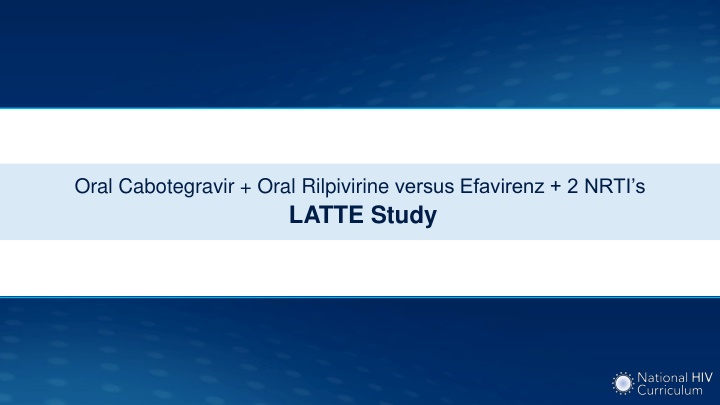
Cabotegravir and Rilpivirine vs. Efavirenz in LATTE Study Results
A comparison study between Cabotegravir and Rilpivirine versus Efavirenz in the LATTE study shows that Cabotegravir plus dual NRTI therapy demonstrated potent antiviral activity during the induction phase. As a two-drug maintenance therapy, Cabotegravir plus Rilpivirine provided antiviral activity similar to Efavirenz plus dual NRTIs up to week 96. This study supported the selection of oral Cabotegravir 30 mg once a day for further evaluation, preceding studies on long-acting injectable formulations of both drugs for HIV-1 treatment.
Download Presentation

Please find below an Image/Link to download the presentation.
The content on the website is provided AS IS for your information and personal use only. It may not be sold, licensed, or shared on other websites without obtaining consent from the author. If you encounter any issues during the download, it is possible that the publisher has removed the file from their server.
You are allowed to download the files provided on this website for personal or commercial use, subject to the condition that they are used lawfully. All files are the property of their respective owners.
The content on the website is provided AS IS for your information and personal use only. It may not be sold, licensed, or shared on other websites without obtaining consent from the author.
E N D
Presentation Transcript
Oral Cabotegravir + Oral Rilpivirine versus Efavirenz + 2 NRTIs LATTE Study
Oral Cabotegravir + Oral Rilpivirine versus Efavirenz + 2 NRTIs LATTE Study: Design Oral CAB 10 mg + 2 NRTI s (n = 60) Oral CAB 10 mg + Oral RPV 25 mg (n = 52) Background: Phase 2b, randomized, partially blinded study done at multiple centers in the U.S. and Canada Oral CAB 30 mg + 2 NRTI s (n = 60) Oral CAB 30 mg + Oral RPV 25 mg (n = 51) Inclusion Criteria - Age 18 years - Antiretroviral-na ve - HIV RNA >1,000 copies/mL - CD4 count >200 cells/mm3 - CrCl >50 mL/min - No hepatitis B - No significant transaminitis Oral CAB 60 mg + 2 NRTI s (n = 61) Oral CAB 60 mg + Oral RPV 25 mg (n = 53) Efavirenz 600 mg + 2 NRTI s (n = 62) Efavirenz 600 mg + 2 NRTI s (n = 46) 24-week lead-in phase Source: Margolis DA, et al. Lancet Infect Dis. 2015;15:1145-55.
Oral Cabotegravir + Oral Rilpivirine versus Efavirenz + 2 NRTIs LATTE Study: Results Oral Cabotegravir + 2NRTIs Oral Cabotegravir + Oral Rilpivirine Efavirenz + 2NRTIs Induction* Maintenance* 100 HIV RNA <50 copies/mL (%) 86 80 82 76 74 71 60 63 40 20 156/181 46/62 149/181 44/62 137/181 39/62 0 Week 24 Week 48 Week 96 *Cabotegravir data is composite of all cabotegravir doses Source: Margolis DA, et al. Lancet Infect Dis. 2015;15:1145-55.
Oral Cabotegravir + Oral Rilpivirine versus Efavirenz + 2 NRTIs LATTE Study: Results Induction* Maintenance 100 HIV RNA <40 copies/mL 80 60 Oral Cabotegravir 10 mg + Oral Rilpivirine 40 Oral Cabotegravir 30 mg + Oral Rilpivirine Oral Cabotegravir 60 mg + Oral Rilpivirine 20 Efavirenz 600 mg + 2NRTIs 0 0 12 24 36 48 60 72 84 96 Treatment Week *During induction phase cabotegravir administered with investigator chosen 2NRTIs Source: Margolis DA, et al. Lancet Infect Dis. 2015;15:1145-55.
Oral Cabotegravir + Oral Rilpivirine versus Efavirenz + 2 NRTIs LATTE Study: Conclusions Conclusions: Cabotegravir plus dual NRTI therapy had potent antiviral activity during the induction phase. As a two drug maintenance therapy, cabotegravir plus rilpivirine provided antiviral activity similar to efavirenz plus dual NRTIs until the end of week 96. Combined efficacy and safety results lend support to our selection of oral cabotegravir 30 mg once a day for further assessment. LATTE precedes studies of the assessment of long-acting injectable formulations of both drugs as a two-drug regimen for the treatment of HIV-1 infection. Source: Margolis DA, et al. Lancet Infect Dis. 2015;15:1145-55.
Acknowledgments The National HIV Curriculum is supported by the Health Resources and Services Administration (HRSA) of the U.S. Department of Health and Human Services (HHS) as part of an award totaling $1,000,000 with 0% financed with non-governmental sources. The contents are those of the author(s) and do not necessarily represent the official views of, nor an endorsement, by HRSA, HHS, or the U.S. Government. For more information, please visit HRSA.gov. This project is led by the University of Washington Infectious Diseases Education & Assessment (IDEA) Program.
